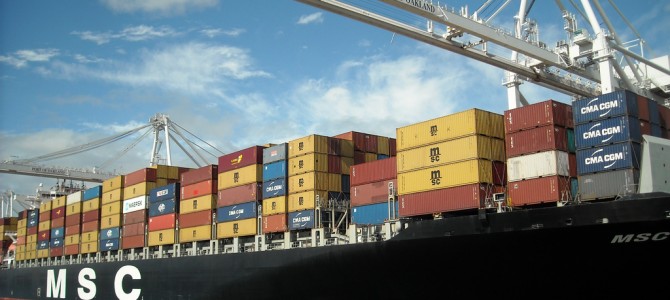
Americans currently pay high taxes on food, clothing, automobiles, industrial inputs and other goods and services, and their own United States Trade Representative is vigorously fighting other countries to keep it that way. Even worse, the government’s efforts all but ensure that removing such taxes – and easing the artificial burdens they place on American families and businesses – will remain unnecessarily, and irrationally, difficult for years to come.
This is the awful state of American trade policy, and serious reform is long overdue.
Americans tend to think of the United States as some sort of free trade bastion in which unfettered globalization is – for better or worse – simply a way of life. However, while many U.S. tariffs were lowered decades ago, several tariff “peaks” remain in certain politically-connected areas like food, clothing, footwear and automobiles. Moreover, “non-tariff barriers” to trade – subsidies, regulations, etc. – have proliferated in recent years, and many “trade remedies” duties – based on allegations of “unfair” trade – also remain in place, particularly for industrial inputs like steel and chemicals.
The pros and (mostly) cons of these government measures vary, but one thing remains constant: their staunch and unflinching defense by the U.S. government in global free trade agreement negotiations. In these venues, gains are viewed as coming only from new access for U.S. exports and investment, while imports are the unfortunate price that America must pay for such “victories.” For example, as negotiations in both the Trans-Pacific Partnership (TPP) and the Transatlantic Trade and Investment Partnership (TTIP) gained momentum earlier this year, blubbering American journalists were quick to proclaim President Obama’s supposed “free trade renaissance” and strong support for expanding U.S. exports, but uniformly failed to report on the fact that his firm resistance to negotiating partners’ calls for lower U.S. trade barriers was a major reason for the agreements’ continuing difficulties. Nor did any such reports delve into the fact that those barriers, while certainly good for certain well-connected companies in the United States, injured the vast majority of American individuals and firms. And when TPP negotiators inevitably miss their much-ballyhooed and over-promised 2013 deadline for completing the agreement, you can bet that these facts will not receive top billing (or maybe even passing mention). Instead, only trading partners’ refusal to heed U.S. export demands will be blamed.
Trade and Reciprocity
The Obama administration, of course, is not the first to engage in such negotiating tactics and instead is simply the latest White House to do so. In fact, since the 1930s, American trade policy has utilized a “reciprocity” model of trade negotiations in which the United States treated any trade liberalization (e.g., the reduction of tariffs), no matter how smart or moral, as a “concession” that is only to be traded for another nations’ own acceptance of new U.S. exports or investment. Moreover, the diplomatic origins of the reciprocity model have ensured that trade liberalization is treated as a foreign, rather than domestic, policy area in which trade negotiations take on a zero-sum, war-like mentality where benefits are “won” or “lost”, instead of mutually achieved. Put most simply, exports are an unquestioned good to be pursued, while imports are an unmitigated bad to be resisted. Full stop.
Even though U.S. foreign and domestic policy – as well as economics, politics and society more broadly – has changed dramatically in the intervening decades, U.S. trade policy remains mired in this 20th century, cold-war framework, as the current TPP and TTIP negotiations make abundantly clear. Unfortunately, some things to not get better with age, and U.S. trade policy is certainly one of those things. In fact, there are at least five fundamental problems with the United States’ mercantilist, reciprocity-based approach to international trade.
First and most basically, it is economically ignorant. Since Adam Smith first penned The Wealth of Nations, there has been a near-universal economic consensus in support of the elimination of trade barriers regardless of whether other nations do likewise. For this reason, there is quite literally no policy issue on which more economists – left, right and center – agree more, and the supposed death of the “free trade consensus” in academia has been wildly exaggerated.
This support, however, goes far beyond mere economic theory: there is also an endless array of empirical and historical evidence demonstrating the value of free trade and free markets. In fact, just last week the Heritage Foundation rounded up a lot of the latest data in order to (once again) resoundingly conclude that trade and investment liberalization is awesome, and that Congress should unilaterally eliminate tariffs on a wide range of products in order to boost the U.S. economy (including U.S. manufacturers). Heritage is certainly not alone: policy shops across the political spectrum, including Brookings, AEI and my colleagues at the Cato Institute, have produced similar studies in the past. And, as Dan Ikenson and I explained in a 2009 paper for Cato, the facts not only support free trade, but also destroy the various myths used by protectionists to undermine public support for such policies, including the greatly-exaggerated “death” of American manufacturing; the alleged link between imports, the trade deficit and U.S. jobs; and the idea that foreign companies and governments routinely cheat in order to gain an “unfair” advantage over their American counterparts.
Second, the reciprocity model has proven increasingly ineffective in producing tangible trade liberalization gains for U.S. businesses and consumers. The biggest example of this failure is WTO’s Doha Round of multilateral trade negotiations, which remains comatose after 12 years of missed deadlines, unkept promises and angry finger-pointing among stubborn nations that refuse to make further “concessions” to finalize the multi-trillion-dollar deal. Even the WTO’s “mini package” of supposedly-low-hanging fruit – intended to jump-start Doha during this December’s ministerial meetings in Bali, Indonesia – appears in doubt.
Smaller, regional/bilateral deals aren’t faring much better. Indeed, according to a recent report from the Asian Development Bank, the entire TPP is at risk of collapsing due to nations’ demands for various protectionist exceptions (or “carve-outs”) from the deal’s general free trade and non-discrimination rules:
The need to provide exemptions, or “carve outs,” to avoid a collapse in negotiations also raises concerns over the final form the TPP will take. The secrecy surrounding the negotiations makes it difficult to assess progress, but—from what is known—there is the risk of degenerating into a series of loosely tied bilateral deals. Indications are that the two largest TPP members—the U.S. and Japan—are proceeding along bilateral lines, threatening the demanding single-undertaking approach the TPP is supposed to adopt.
Although the number of countries involved in these negotiations is much lower than at the WTO, for instance, it does not translate to a commensurate reduction in diversity in terms of disparate interests. These interests often conflict, especially in a context where the agenda is far more ambitious than any other proposed thus far. The recent round of negotiations that took place in Brunei Darussalam in August 2013 was reported to have made very little progress, highlighting the difficulties being faced as the TPP moves toward finding common ground on the more difficult issues.
Bloomberg has more on the ADB report and the TPP’s current problems here. Among the carve-outs demanded by TPP participants are Japan’s agricultural protectionism and Malaysia’s imposition of discriminatory regulatory barriers to tobacco, but many such demands originate in Washington, including three of the negotiations’ most contentious issues:
- Sugar protectionism. The United States has not only resisted calls to liberalize archaic tariffs and quotas on sugar imports, but also refused to reopen the current U.S.-Australia FTA, which completely excludes sugar from the Agreement.
- Textiles, apparel and footwear. The Obama administration has repeatedly refused requests from Vietnam and other large exporters to lower U.S. tariffs on textiles, clothing and shoes, and has demanded complicated “rules of origin” that will dramatically narrow the goods that could qualify for preferential access to the U.S. market.
- Automobiles. The United States also has vigorously fought Japan over U.S. tariffs on automobiles (2.5% for cars and a whopping 25% for light trucks) – a nearly-identical request that delayed the implementation of the U.S.-Korea FTA for several years after it was originally signed by the Bush Administration.
Each of these issues not only hurts U.S. consumers (more on that below), but threatens the completion of the TPP itself – an absolutely dumbfounding prospect, given these sectors’ relative insignificance for both the agreement and the U.S. economy.
The third flaw in the current system is that it’s needlessly messy and archaic. Every U.S. FTA, from NAFTA to KORUS, contains a different “schedule” which dictates the level and timing new market access for individual FTA partners’ goods and services. Rules of origin and other commitments also vary widely across agreements, thus creating an impenetrable web of rules and regulations and making the U.S. tariff code look like the Rosetta Stone. As a result, the exact same product will be subject to different taxes and rules based solely on its origin and the year in which it enters the country, and U.S. businesses often make sourcing decisions based on FTA rules rather than a product’s actual value. (And, of course, they must spend millions of dollars annually to determine those rules!)
Not only is this process costly and inefficient, but it is wholly out of step with the 21st century world of seamless and ever-changing global supply chains. Today, product components are often sourced from multiple countries and assembled in another, and sourcing patterns routinely change based on market developments. (See, e.g., the evergreen “origins” of the iPhone and its competitors.) Arcane trade rules prevent such dynamism and thus hurt U.S. companies and consumers. Put another way, goods today are “made on earth,” but our trade agreements reflect a bygone era of vertical manufacturers, simplistic designs and old-fashioned notions of bilateral trade among individual nations. It makes no sense. None.
Fourth, the United States’ “free trade” policy has proven to be a horrible tool for actually achieving and sustaining public support for trade liberalization and free markets. For one thing, focusing on exports, FTAs and arcane market access issues (e.g., pharmaceutical patent protections) gives many Americans the not-totally-unwarranted impression that our trade policy is little more than a tool of large multinational exporters and investors at the expense of American workers. That is hardly a way to achieve grassroots support for important economic policy!
More importantly, the constant focus on exports and resistance to any type of import liberalization actually breeds public misunderstanding and distrust of trade liberalization. As Dan Ikenson and I explained in 2011:
The pervasive view that exports are good and imports are bad is a central misconception upon which rests the belief that trade negotiations and “reciprocity” are essential to trade liberalization. Under this formulation, an optimal trade agreement, from the perspective of U.S. negotiators, is one that maximizes U.S. access to foreign markets and minimizes foreign access to U.S. markets. An agreement requiring large cuts to U.S. tariffs, which would thus deliver significant benefits to consumers, would not pass political muster unless it could be demonstrated that even larger export benefits were to be had. This misguided premise that imports are the cost of exports and should be minimized lies at the root of public skepticism about trade. Ironically, it is also a prominent feature of the favored pro-trade argument.
There is nothing, of course, wrong with exports or pursuing new market access for U.S. businesses. The political appeal of that message is obvious, and exports do contribute to economic growth and, thus, job creation. However, the U.S. government’s relentless obsession with exports and reciprocity not only confuses the public and reinforces bad economics, but also creates a large and unnecessary opening for misleading protectionists:
[The mecantilist] message invites the following retort: if exports help grow the economy and create jobs, then imports must shrink the economy and cost jobs. In failing to explain why that conclusion about imports is wrong, trade proponents have yielded the floor to trade skeptics, who have been more than happy to manufacture talking points about the “deleterious” impact of imports on the U.S. economy. Most of those talking points are misleading or plain wrong, but there has been inadequate effort to correct the record. As a result, too many Americans accept the mercantilist fallacy that exports are good, imports are bad, and the trade account is a scoreboard.
Birdcages across the country are lined with op-eds from protectionist union leaders, businessmen and “consumer protection” groups that turn FTA proponents’ mercantilist message against them. Indeed, just this month I was treated to a piece in my hometown paper from the NC AFL-CIO, arguing that the U.S.-Korea FTA – and U.S. free trade policy more broadly – was a clear disaster for North Carolina because imports from Korea increased in the agreement’s first year, while U.S. exports declined. (Nevermind the fact that Korea’s economy was struggling mightily in 2012 and thus represented a low-demand export market, or that free trade resoundingly benefits the Tarheel state.) Sadly, using the Obama administration’s own misguided metric for gauging an FTA’s success (i.e., exports and the trade balance), the union had a point and thus capably hoisted the administration on its own mercantilist petard. And until the U.S. government changes this shortsighted, incorrect approach to trade policy and messaging, this rhetorical weapon will be readily available to protectionists, and public opinion will remain subject to the whims of meaningless statistics instead of economic consensus and actual historical fact.
Trade and Morality
Finally, the current approach to U.S. trade policy is manifestly immoral. Government intervention in voluntary economic exchange on behalf of some citizens necessarily comes at the expense of others and is inherently unfair, inefficient, and subverts the rule of law. At their core, trade barriers like those for sugar, clothing, footwear and automobiles are the triumph of coercion and politics over free choice and economics. The protectionist policies that USTR fights to maintain are the result of productive resources being diverted to achieve political ends and, in the process, taxing unsuspecting consumers to line the pockets of the special interests that succeeded in enlisting the weight of the government on their side.
This immorality has a clear and tangible cost. In 2011, Americans paid over ten billion dollars in tariffs on clothing alone, and another two billion each for shoes and automobiles – $29 billion total that year and $40 billion total in 2012. These taxes also raise the prices of goods made here at home and, as a result, American families pay much more for everyday staples like butter, milk, ice cream, sugar, tuna, apparel and shoes than their foreign counterparts. And American companies do the same for industrial inputs like ball bearings, steel and cement.
Protectionism is akin to earmarks, but it comes out of the hides of American families and businesses instead of the general treasury. And under the current trade negotiations system, our government is essentially choosing certain U.S. businesses and workers – those seeking protection and those seeking new export markets – over everyone else in America. As a result of these taxpayer-funded efforts, U.S. families pay higher prices for everyday essentials, and import-consuming companies struggle to remain globally competitive. (See, for example, U.S. candy makers who have moved their operations, and thousands of jobs, overseas due to sky-high sugar prices here.) Why on earth should our government pursue such an obviously immoral approach to international economic policy? Obvious answer: it shouldn’t.
A Better Path Forward
Fortunately, there is a much better, simpler way forward for U.S. trade policy. Most obviously, the United States should (i) immediately and unconditionally eliminate tariffs on basic human necessities like food, clothing, shoes, as well as industrial inputs that U.S. manufacturers rely upon to remain globally competitive; and (ii) phase out all other tariffs over a relatively short transition period. This change, coupled with matching rhetorical shift about the domestic benefits of trade liberalization, would instantly put the United States back at the forefront of global economic policy and in line with longstanding economic doctrine, fundamental fairness and modern business practices.
And, contrary to popular belief, such moves are politically possible: not only have countries like Australia, Chile, China, New Zealand, Canada, Mexico and Colombia pursued unilateral import liberalization in recent years in order to boost their economies, but the U.S. government also has done so via more limited initiatives like the Generalized System of Preferences and the Miscellaneous Tariff Bill (and sold such policies by – rightly – emphasizing their benefits to U.S. businesses and consumers). These policies would resonate with policymakers on the right and left, particularly in this era of increasing bipartisan disdain for corporate welfare. They would be consistent both with conservatives’ principled opposition to higher taxes and big government interventionism, and with liberals’ opposition to regressive taxation.
Furthermore, the unilateral elimination of tariffs would not lead to a flood of “unfair” imports that destroy U.S. industry because we already have trade remedy laws designed to address such situations and, due to years of domestic industry lobbying, are extremely biased towards protection. (Not to mention the fact that the vast majority of imports are already “fairly traded.”)
Speaking of which, the United States also should pursue fundamental reforms of its trade remedy laws to ensure that they actually address unfair and injurious imports (rather than domestic lobbying) and take into account the broader public interest – including U.S. consumer concerns. Our government should be ever vigilant of the fact that American consumers, not foreign exporters or governments, pay U.S. “unfair” trade duties, and these measures should therefore be a last resort.
Other regulatory reforms also are necessary, such as the elimination of most U.S. subsidy programs and various forms of “regulatory protectionism,” such as the Lacey Act and Dodd-Frank rules on “conflict minerals,” all of which thwart competition, raise prices and distort domestic and global markets.
Finally, the United States should complement these important changes by coupling them with “American competitiveness agenda” in order to give U.S. workers and companies what they really need to compete in today’s global economy: lower individual and corporate taxes in order to reflect new global norms, limits on lawfare and professional/occupational licensing, energy deregulation, etc. Such changes would boost economic growth, eliminate most domestic demands for protection from low-cost foreign competition, and, combined with the aforementioned tariff liberalization, boost U.S. exports without the need for slow and messy reciprocal trade negotiations. (Remaining trade barriers could be addressed via more aggressive litigation of existing rights and obligations under WTO rules and a “name and shame” approach to the most egregious transgressors.)
The global economy is advancing at a breakneck pace, but U.S. trade policy is stuck in neutral. Our elected leaders ignore basic facts and economics and pursue negotiations that not only benefit a well-connected cabal of businesses and lobbyists at the expense of U.S. consumers, but also undermine long-term public support for free trade. This archaic, immoral approach has produced diminishing returns in recent years and has called into question almost 70 years of U.S. leadership in the global economy. Meanwhile, other countries press ahead with agendas that better serve their citizens and reflect the realities of modern global supply chains, multinational investment and other key aspects of the 21st century economy.
It’s time America did the same.
The views expressed herein are Scott Lincicome’s alone and do not necessarily represent the views of his employer, White & Case, LLP.









